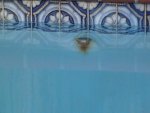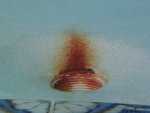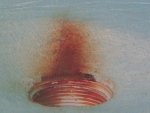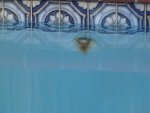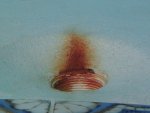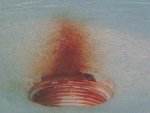The two close photos are taken from above so are an inverted view.
The white/clean spot of the PVC threads is where a Vitamin C tab was left to dissolve
It is a Return, used for a Polaris cleaner & PoolSkim.All PVC fittings on those cleaners; the female parts in the wall are PVC.Female fittings installed & used for > 10yrs.
Vitamin C used to verify it is rust. Plaster is cleaning up OK but next day that “lowest darkest part†on the circumference has new rust formation which puffs away when disturbed.
Verified visually & by hand that there is no apparent crack in the female PVC fittings & there does not seem to be loss of plaster exposing metal- but obviously some metal is exposed & my guess is at “that lowest darkest partâ€- just undetectable. Did fiddle with the fitting at the May opening this year to install a PoolSkim. Hand tightened stuff but I do recall needing a pipe wrench a time or 2; perhaps some plaster was chipped but it doesn’t feel or look like that, so I assume a crack in the fittings but I see no cracks. I assume it must either be a crack in the female fitting that I cannot see, or a chip exposing metal at that lowest darkest part but I can’t imagine metal that close to the surface. I left the PoolSkim attached since May since it’s a PITA to place & remove, then 2-3 weeks ago I saw a rust spot, so I removed the PoolSkim to view in entirety.
Lowest part of the female fitting is about 4 inches below the water line ( about where I drain to when I winterize in the October, 3 ½ months from now).
How do I fix this?
Can I fix this rust spot?
If not, what do I need to be sure happens by the pool guy?
I should get on this pretty quick or ok to wait until fall lowering?
If ok to delay until fall, should I do something daily or weekly until then?
Is there a fix to this without lowering the water level?
Is this rebar? Can’t believe there is a metal aspect to the female fitting?
I will also post this at the building threads of this form since those guys may not always be checking this section
Thanks
The white/clean spot of the PVC threads is where a Vitamin C tab was left to dissolve
It is a Return, used for a Polaris cleaner & PoolSkim.All PVC fittings on those cleaners; the female parts in the wall are PVC.Female fittings installed & used for > 10yrs.
Vitamin C used to verify it is rust. Plaster is cleaning up OK but next day that “lowest darkest part†on the circumference has new rust formation which puffs away when disturbed.
Verified visually & by hand that there is no apparent crack in the female PVC fittings & there does not seem to be loss of plaster exposing metal- but obviously some metal is exposed & my guess is at “that lowest darkest partâ€- just undetectable. Did fiddle with the fitting at the May opening this year to install a PoolSkim. Hand tightened stuff but I do recall needing a pipe wrench a time or 2; perhaps some plaster was chipped but it doesn’t feel or look like that, so I assume a crack in the fittings but I see no cracks. I assume it must either be a crack in the female fitting that I cannot see, or a chip exposing metal at that lowest darkest part but I can’t imagine metal that close to the surface. I left the PoolSkim attached since May since it’s a PITA to place & remove, then 2-3 weeks ago I saw a rust spot, so I removed the PoolSkim to view in entirety.
Lowest part of the female fitting is about 4 inches below the water line ( about where I drain to when I winterize in the October, 3 ½ months from now).
How do I fix this?
Can I fix this rust spot?
If not, what do I need to be sure happens by the pool guy?
I should get on this pretty quick or ok to wait until fall lowering?
If ok to delay until fall, should I do something daily or weekly until then?
Is there a fix to this without lowering the water level?
Is this rebar? Can’t believe there is a metal aspect to the female fitting?
I will also post this at the building threads of this form since those guys may not always be checking this section
Thanks


